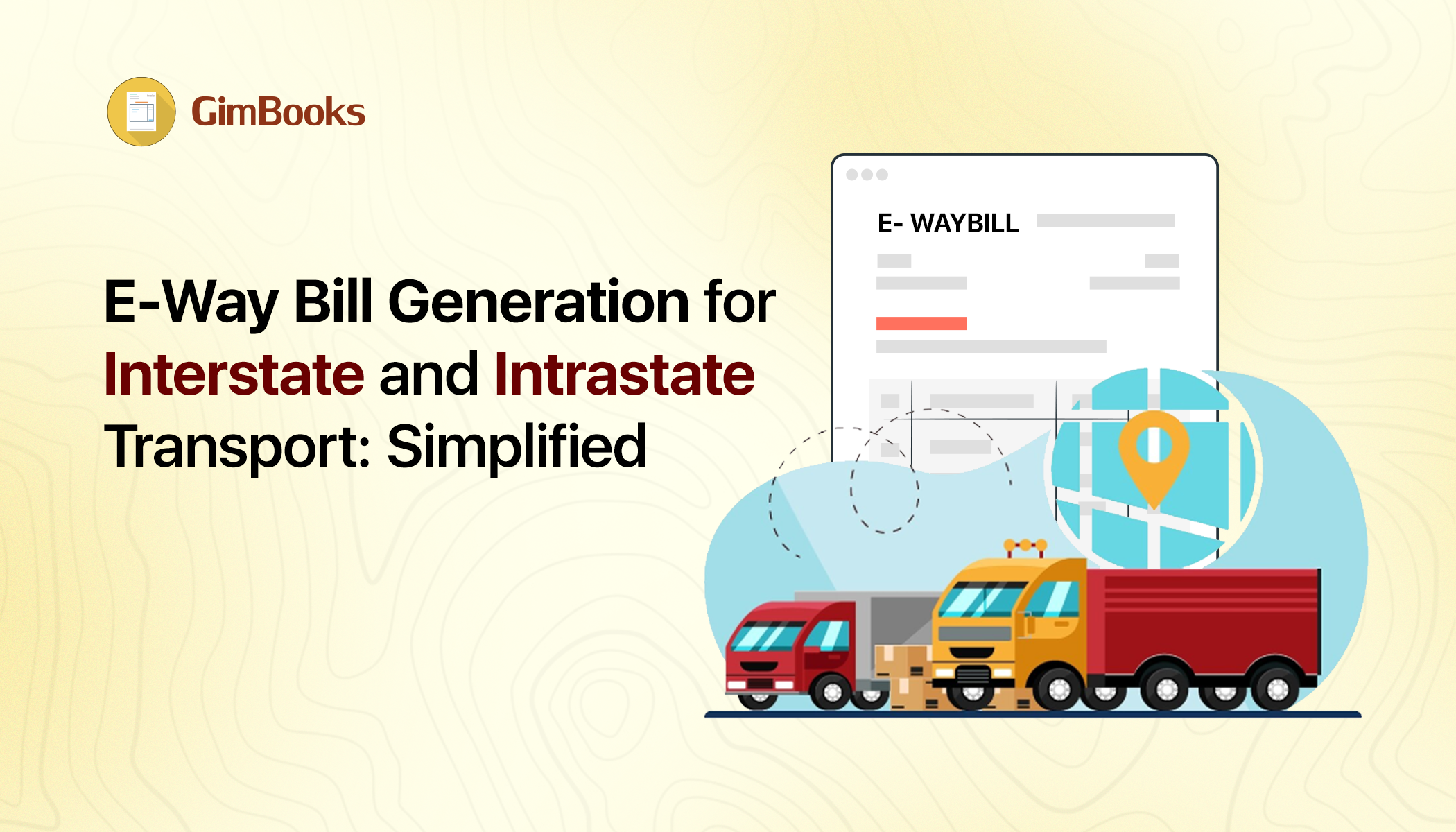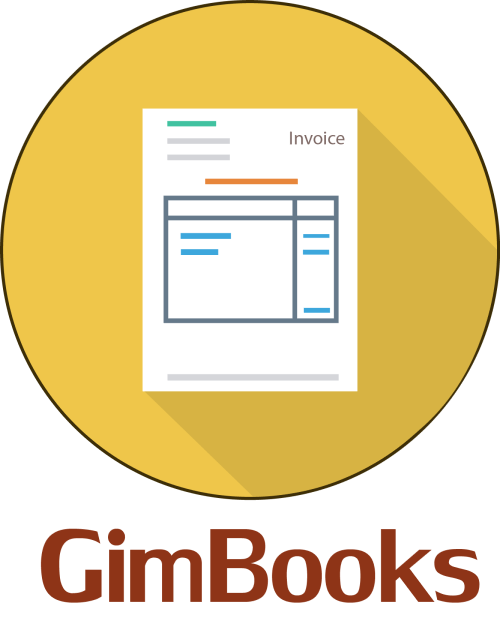E-Way Bill Generation for Interstate and Intrastate Transport: Simplified
Find a simple way to generate E-Way Bills for interstate and intrastate transport. Explore the process of e-waybill generation without OTP with GimBooks.

Importance of E-WayBill Generation
E-Way Bill generation for intrastate and interstate transportation is a very essential part of India's GST regime and has completely changed the mechanism of goods transportation within the country. If you're transporting goods from one state to another or within your state, you must be aware of generating an E-Way Bill for smooth and effective logistics.
This blog explains the whole E-Way Bill phenomenon, explaining the process, the rules, and why transporters and companies need to be aware.
What is an E-Way Bill?
Electronic Way Bill is a bill which has to be created for the consignment whose value is greater than Rs 50,000/- on the E-way bill portal by a GST-registered taxpayer or company. This makes the e-waybill generation process transparent, reduces tax evasion, and simplifies the transportation of goods under the GST regime.
E-Way Bill Generation: A Step-by-Step Process
It is quite simple to generate an E-Way Bill. Below is the process by which you can generate an E-Way Bill:
✅Step 1: Log in to the GST Portal
Visit the official GST website, https://ewaybillgst.gov.in, and log in using your credentials.
✅Step 2: Enter Details
Enter the following details:
Consignor and Consignee Information: GSTIN of recipient and supplier.
Invoice Information: Invoice value, date, and number.
Product Information: Value and quantity of goods, description, and HSN code.
Text: Transportation Details: Vehicle number and mode of transport (air or ship, railway, road).
✅Step 3: Create the E-Way Bill
Once all the details are input, you must click on "Generate E-Way Bill." The system will generate a unique E-Way Bill Number (EBN) that can be sent to the transporter.
✅Step 4: Print or Share Electronically
The E-Way Bill is printable or can be shared electronically with the transporter and other stakeholders.
There are two E-Way Bill Rules for Interstate and Intrastate Transport-
1. Interstate Transport
Applicability: Mandatory for the movement of goods between two states.
Validity: Depends on the distance:
Up to 100 km: 1 day
For every additional 100 km: 1 extra day
Who Can Generate: The supplier, recipient, or transporter.
2. Intrastate Transport
Applicability: Required for the movement of goods within a state.
Validity: Same as interstate transport.
There are state-specific rules and as such there may be more requirements that apply only to a particular state so it is very important that you check on the local level.
Key Features of the E-Way Bill System: Logistics Management
✅Track your goods easily: Know where your shipment is at any time. It's all transparent.
✅Works for any transport: Whether you're sending goods by truck, train, plane, or ship, you can use an E-Way Bill.
✅Update vehicle details: Transporters can easily update vehicle information in Part B of the E-Way Bill.
✅Cancel if needed: Made a mistake? Cancel the E-Way Bill within 24 hours if the goods haven't moved yet.
Benefits of E-Way Bill Generation
✅Easy paperwork: Making and managing E-Way Bills is all online, so it's much simpler. No more running around with physical forms!
✅Quicker deliveries: E-Way Bills mean less time stuck at check posts. Your goods get where they need to go faster.
✅Better records: You keep digital records of all your shipments, making things organized and easy to find.
✅Safer business: E-Way Bills help stop fraud and illegal transport, keeping your goods safe.
Common Challenges and Solutions
1. Technical Glitches
Challenge: Users may face issues while generating E-Way Bills due to technical errors on the GST portal.
Solution: Ensure a stable internet connection and use updated browsers. Contact the GST helpdesk for assistance.
2. Incorrect Details
Challenge: Errors in invoice or transport details can lead to rejection.
Solution: Double-check all information before generating the E-Way Bill.
3. Validity Expiry
Challenge: E-Way Bills may expire if the goods are not transported within the specified time.
Solution: Plan shipments carefully and extend the validity if necessary.
Tips for Efficient E-Way Bill Management
✅Use GST Software: Integrate GST-compliant software to automate E-Way Bill generation and tracking.
✅Train Your Staff: Ensure your staff is well-trained in E-Way Bill rules and processes.
✅Stay Updated: Keep track of changes in E-Way Bill rules and GST regulations.
✅Maintain Records: Store digital copies of all E-Way Bills for future reference.
Conclusion
The E-Way Bill generation has been made mandatory for the interstate movement or transportation of goods, as per the regulations framed under the GST law. The requirement to know how the E-Way Bill is generated forms part of effective logistics management, be it interstate transport or intrastate rules and compliance.
GimBooks' one-click OTP-free E-Way Bill generation will keep your business growing, save your time, and save you from penalties thereby considerably reducing the effort involved in this process.
Following the steps and guidelines outlined in this blog will enable companies to ensure that there is smooth movement of goods, avoid penalties, and enhance their supply chain activities.
To enjoy one-click OTP-free E-Way Bill generation, download GimBooks today!
FAQs on E-Way Bill Generation
1. Is an E-Way Bill required for all goods?
No, it is only required for goods worth more than ₹50,000.
2. Can an E-Way Bill be canceled?
Yes, it can be canceled within 24 hours of generation if the goods are not transported.
3. Who is responsible for generating the E-Way Bill?
The supplier, recipient, or transporter can generate the E-Way Bill.
4. What happens if an E-Way Bill is not generated?
Failure to generate an E-Way Bill can result in penalties and delays in the movement of goods.

